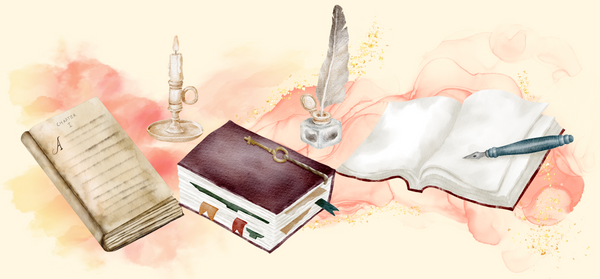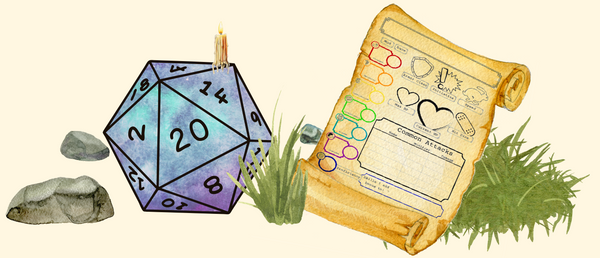How to make DnD character sheets easier for beginners to understand
Posted by Annabelle Collins on
We’ve all been there. That first time staring at a character sheet and just feeling overwhelmed. For a lot of new players character sheets are one of the biggest barriers to playing the game. If you want to make Dungeons and Dragons easier for your players (or yourself!) it’s really worth considering what kind of character sheet to use. I’ve laid out four options to make 5e character sheets easier to understand. These are; using pre-generated character sheets, digital character sheets, character sheets designed for accessibility and of course, colour coding a “standard” paper character sheet.
Using pre-generated character sheets and stat blocks.
For a lot of beginners the concept of building a whole character - their race, their class, proficiencies, background, features, spells - is so overwhelming they simply don’t begin. This is especially true if they don’t have much free time in their week. Some people love the process of making character sheets but for a lot of people it just feels like work. DnD is a game that we play for fun, if making a character isn’t fun for you then why would you do it?
Characters get developed during game play anyway - it’s totally ok to use a pre-generated character sheet as inspiration for yours.

You can get some easy to understand, pre-generated sheets from Wizards of the Coast here.
The sheets are formatted as an A4 Page (s) with a stat block in the corner and backstory and more detailed notes wrapped around, making it very easy for a complete newbie to pick up a sheet and begin playing.

There are sheets available for each character for every level right up to level 10 which also removes the stress of levelling up that character down the road.
Wizards of the Coast have broken the classes down into 4 types;
Warrior, Scoundrel, Mage and Healer
for you or your players to choose from.
Pre-generated character stat blocks aren’t for everyone, but I think they do a lot for making DnD easy to play - especially for beginners.
Digital Character Sheets
Digital character sheets are another excellent way of making your character sheet easy to understand.
DnD Beyond has a free character sheet builder (though you’ll need to make an account) that makes building a character much simpler.
Character sheets on there have tabs for your Actions, Spells, Equipment etc. making it easy to flick to where you will find the information you need. By clicking “Cast” next to the spell you use, your spell slots will automatically be marked as they are used. Clicking on the spell name brings up a tab to the right with an explanation of what that spell does, the components needed to cast it and any other necessary information. I can’t stress how useful that is when you’re playing a caster!

As well as all that, you can choose to digitally roll dice and automatically add up any modifiers. This can save a lot of time and confusion when players fumble around with their dice wondering if this is the D12 or the D20. It’s also incredibly useful for making DnD accessible for folks who struggle with maths.
Another point in favour of the digital dice is that when players are all part of the same campaign; when a dice is rolled they can all see the result, both eliminating the fear of cheating and allowing everyone to react to natural 1’s with collective horror!
Charactersheets made for accessibility
Digital character sheets can still be overwhelming for new players. To make character sheets really accessible I recommend using a template like the one I’ve made below. I’ve designed it for Level 1 characters who don’t have too much to write on their sheets but it can be adapted for higher levels too.
This character sheet has dyslexia-friendly fonts, as well as icons to make different stats easier to understand. I removed extra things like features and traits that are looked at less frequently, as they can be written on a separate sheet if wanted.
I DM for new players a lot and have run games for children, neurodiverse charities, colleagues, senior leadership events, curious family and more. I’ve found that for complete novices who are just curious in trying out the game, having a simple, easy-to-understand character sheet can make all the difference! Once they’re hooked and asking more questions, then you can introduce them to the full sheet.
Feel free to copy my design and use as you see fit!

Here's a useful Link to Google-Doc
Colour Coding normal character sheet
For those of you that just want to use the traditional paper character sheet there is another good option. Colour code it!
Colour the box with your AC in red, your initiative in orange, your hitpoints in pink, speed in yellow, skills in green, saves in blue, and attacks / spellcasting in purple. You can colour other bits as you see fit but those are the main ones.
Then, when DM’ing for new players it can make it much easier for them to find things on their sheet if I say “What’s your Armor Class? It’s the number in the red box” or “Make a Stealth check! It’s in the green box about halfway down. Roll a D20 and add that number to your roll”.
It can really speed up gameplay as well as make your players feel more confident.

Personally I love DM’ing for new players. I love that moment when they realise how open the world really is and that they are not stuck to programmed options. Part of my job as a DM is to make it as easy as possible for my players to enjoy the game, and catering charactersheets to their needs is a really great way to start!


Hi! I'm Annabelle! I'm the author of this blog and a huge nerd!
I also make magnetic, double-sided, modular dungeon tiles!
My DnD terrain contains secret spinning magnets so that each piece snaps instantly to every other. They even come in a box disguised as a spellbook to store away on your bookshelf!
They're really cool, you should totally check them out here!


Oh congratulations on DMing for the inlaws! I love introducing new folks to the game :D Good luck with everything! A one-shot is a nice way to start – give them a taste without it being such a huge time commitment. I hope you have a really fun game together! :D
Hi Annabelle! First off thank you so much for these tips and fantastic work on the simplified colour coded character sheets! I’m going to be teaching my in-laws how to play soon, it’ll be their first ever experience! I’ve DMed before but for family and friends who have had experience with D&D or D&D based RPG’s so it was easier. I’m planning on running one of the Candlekeep mysteries short one offs. Wish me luck!
Ahhh thank you so much! That makes me really happy to hear! :D :D
I also have ADHD (it really helps me with my DMing!) and have run games for several folks with autism. I really wanted to try make the game accessible for everyone!
I’m going to be trying to some more accessability-focussed posts in the near future so I hope those can be helpful for you guys too! :)
I am teaching my son D&D and this is such a neat simple design! He has ADHD and autism so I was really excited by how simple this is! I want to make it fun for him. Thank you!